Reviewer's Note: The ThruNite Catapult V2 was provided by ThruNite. Their website is not updated with this new version yet, but you can find details on it at their CPFMP thread or at Battery Junction.
Warning: pic heavy, as usual
Manufacturer Specifications: (taken from the ThruNite CPFMP thread and Battery Junction's website).
Please see my earlier V1 review for comparison specs.

In addition to the specs above, here are the main changes (according to ThruNite):





The V2 light comes with a simpler carboard case with cut-out foam. Inside, you will find the light, extension body tube, warranty card, wrist lanyard, spare o-rings and extra tailcap clicky switch and GITD boot cover.
Here is how it looks in my hands, and compared to a couple lights of its class:
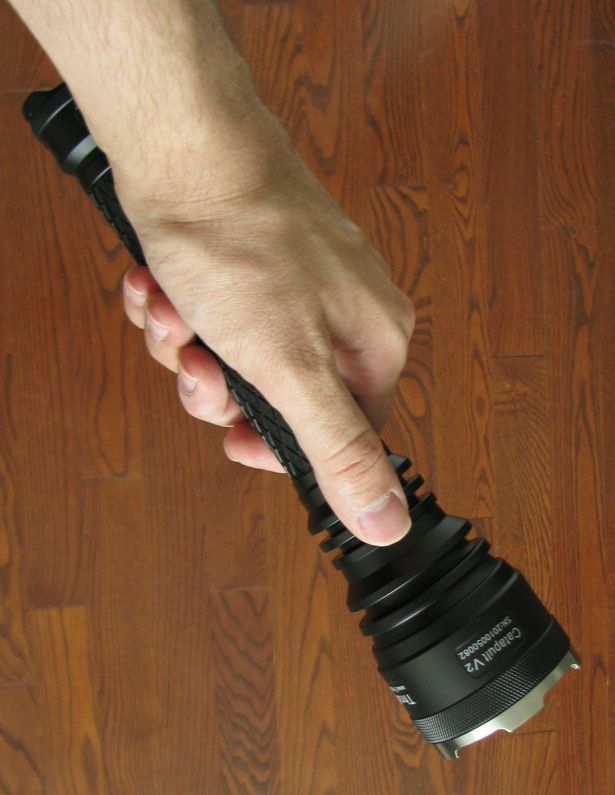


From left to right: AW 18650 Protected, Catapult V2, Catapult V1, JetBeam M1X, Tiablo ACE-G, EagleTac M2C4 (all with battery extenders)


From left to right: AW 18650 Protected, Catapult V2, Catapult V1, Olight M30, JetBeam M1X, JetBeam Jet-III M (all without battery extenders)
Catapult V2 Weight (no battery): 375.7g (no extender), 446.4g (with extender)
Catapult V2 Dimensions: 187mm (no extender), 254mm (with extender), Width (bezel) 58.0mm, Width (tailcap) 35.0
Catapult V1 Weight (no battery): 339.3g (no extender), 410.5g (with extender)
Catapult V1 Dimensions: Length: 182mm (no extender) 250mm (with extender), Width (bezel) 59.0mm, Width (tailcap) 34.4mm
As you can see, most of the difference has been around the head of the light – with an additional ~36g and ~4.5 mm in length. This is presumably to accommodate the greater heatsink and the new head-twist output control mechanism.
What hasn't changed is the over dimensions, design, screw threads or checked pattern of the handle/battery tube and tailcap. These parts are interchangeable between the versions. Note however that they have switch to slightly thinner (but more durable looking) black o-rings at all junction points.
Grip remains excellent – the Catapult has some of deepest cut checkered patterning that I've ever seen on the surface of a light. Anodizing is comparable between the versions, but lettering is now brighter in appearance than before.

As you can see, the light can tailstand as before (the raised ridges also serve as attachment points for the wrist lanyard). The switch has the same feel as before, and is fairly typical for standard forward clicky switch.

The tailcap is another change – instead of a bare gold-plated spring, there is now a battery contact cap (with a spring underneath). The gold-plated spring mounted on the positive contact board in the head seems comparable (and newer high-capacity flat-top 18650 cells still work fine ).
).
Screw threads in the tailcap and on the corresponding battery tube remain anodized, allowing for lock-out. :thumbsup:
FYI, as before, the extender portion battery tube goes between the head and the main body tube, not between the main body tube and switch (as is the case on most other lights). It's important you don't try to install it the wrong way, or it will interfere with battery contact (i.e. the anodized screw threads will be in the wrong place).


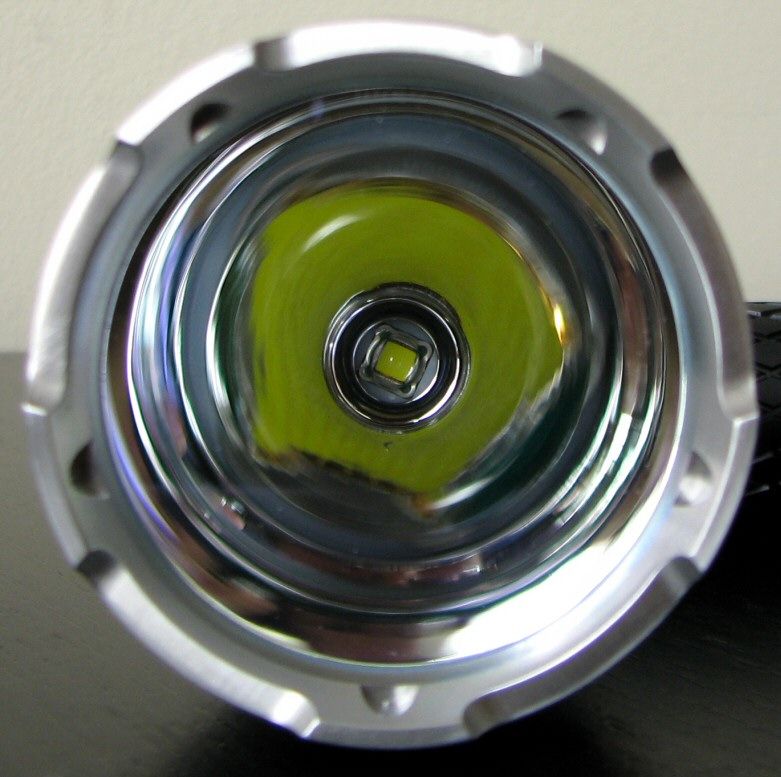
Now much has visibly changed here, except for the stainless steel bezel. My sample came with the standard smooth reflector (although I understand OP is available). Of note – while the lens retains some purplish-tinged anti-glare coating, it is much less noticeable than on my earlier V1 sample.
Beamshots
To start, here are some "white-wall" beamshots, comparing the V1 and V2 Catapult. Both lights are on Hi on 2x18650 AW protected cells.
The first set is taken ~0.5m from a while wall, to show you the spillbeams:




The second set is taken ~2.5m, to show you the hotspots:




I think you will agree - not much of a difference. Frankly, you can only tell a difference using testing equipment. You can check out my V1 review for some additional beamshots.
To better compare the throw and spill of the V2 compared to other high output lights, here are some outdoor shots from my High Output Round-up Review, showing a point ~ 10 meters from the lights. These were taken at different times for different reviews, so they may look a little different (e.g. I planted a tree at the end of last summer :laughing .
.







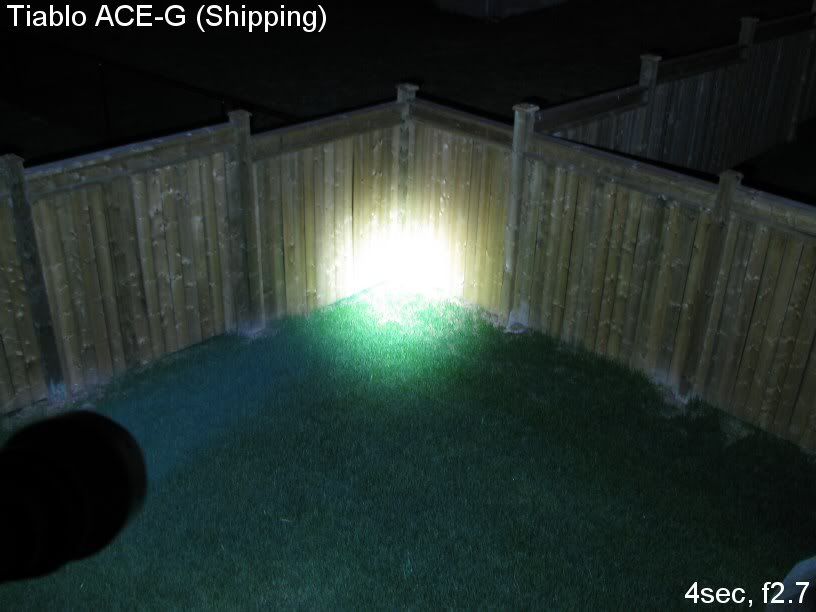
And here are some lower exposures to better show you the hotspots:


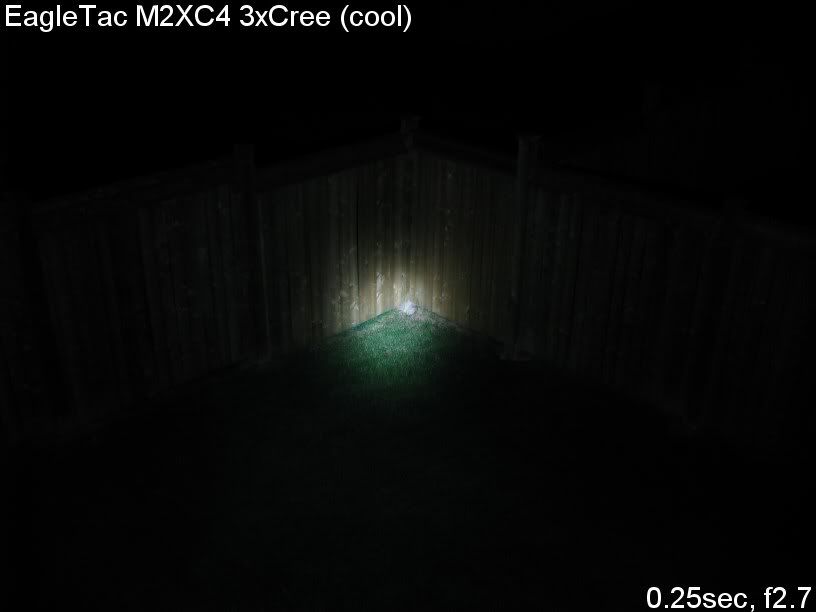





As I think you can see, the Catapult has the greatest throw of any of these lights. :thumbsup:
UPDATE: Some additional long-distance beamshots, to show you how the light compares to others in its class.
Please see my recent 100-yard Outdoor Beamshot review for more details (and additional lights).

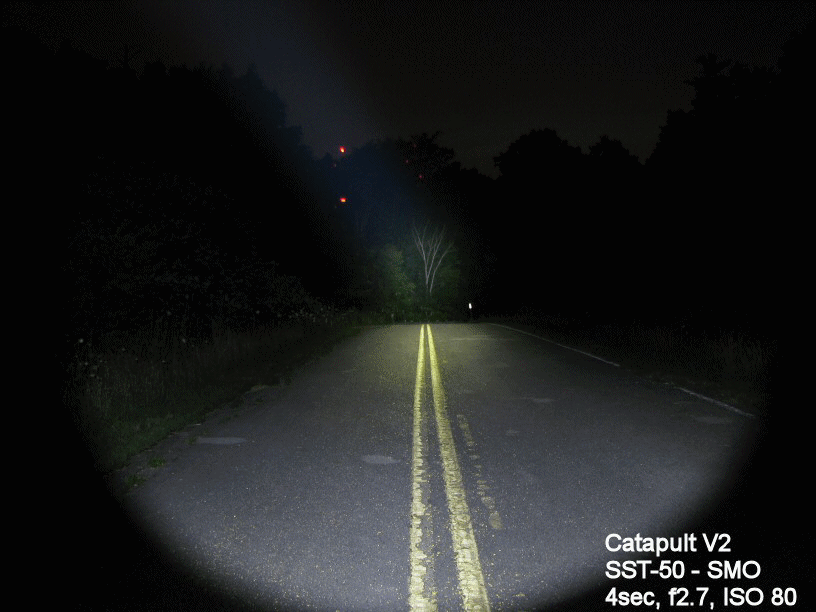

User Interface
The Catapult V2 uses a very simple interface – twist the head tight for Hi, loosen slightly for Lo. Turn on/off by the forward clicky switch (press-on for momentary, click-on for stay on). :kiss:
There is no longer a strobe mode.
Like before, I am unable to detect any sign of PWM at either level with my home-made sound card-oscilloscope setup. :thumbsup: So either the light is current-controlled, or the frequency is incredibly high and undetectable.
Note the voltage range of the circuit has changed – from 2.7V–8.4V on the V1 to 3.7V-13V on the V2. This means you can now run the light in 4xCR123A or 2xCR123A/RCR configurations. :thumbsup:
The light also has a thermal sensor, and will cut-out if the temperature exceeds 120C. A good safety feature, especially when running 4xCR123A on Hi (the internal resistance of those cells can result in a lot more heat being generated when placed under a high load).
Testing Method: All my output numbers are relative for my home-made light box setup, a la Quickbeam's flashlight reviews method. You can directly compare all my relative output values from different reviews - i.e. an output value of "10" in one graph is the same as "10" in another. All runtimes are done under a cooling fan.
Throw values are the square-root of lux measurements taken at 5 meters from the lens, using a light meter, and then extrapolated back to estimate values for 1 meter. This will be my standard way to present throw on these types of high output lights from now on. The beams don't really have a chance to fully converge until typically several meters out
Throw/Output Summary Chart:
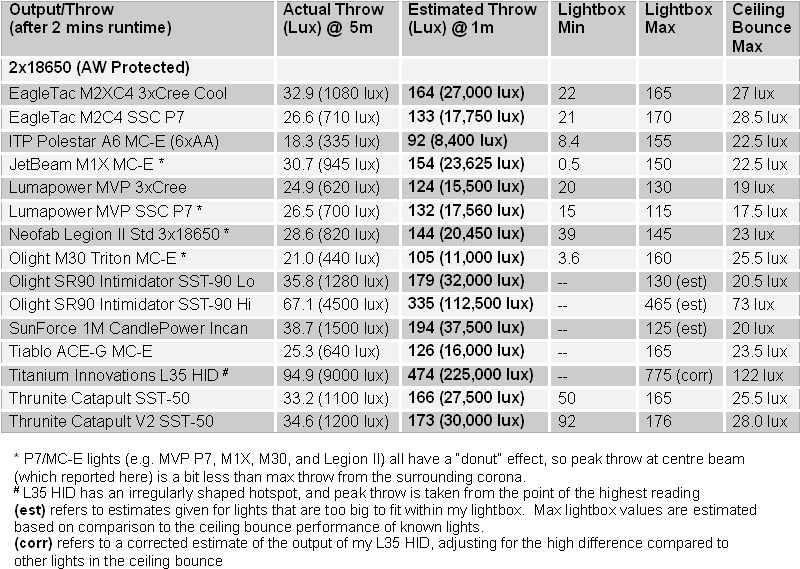
Consistent with ThruNite's claims, max output has increased slightly on my V2 sample (by about ~5% overall). The Lo mode is actually intermediate to the Med/Lo modes of the V1 (scroll down for the runtime comparisons).
Output/Runtime Comparison
Note: Effective January 2010, all CR123A runtimes are now performed solely on Titanium Innovations batteries sponsored by BatteryJunction.com. You can compare the generally excellent performance of these CR123A cells relative to the Duracell/Surefire cells used in all my earlier reviews here. I have marked all the new runtimes of lights with Titanium Innovations CR123As on the graphs with an "*".
All 18650 runtimes are done on older AW protected cells (2200mAh), for comparison purposes.
To start, here are some comparisons between the V1 and V2 Catapults:

Some interesting differences … first off, note that the new V2 Lo mode is intermediate to the previous V1 Lo and Med modes. Efficiency may be slightly improved on the V2 version's Lo mode.
The V2 now supports 4xCR123A, and the Hi level run is unusual – after 27mins, the light drops to a lower regulated level (lower even than the Lo mode). After another 30 mins at this level, output slowly begins to climb back up to the set Lo level – at which point, regulation cuts-off and the light gradually decays in output. The Lo mode on 4xCR123A was perfectly flat in comparison.
I'm not sure why it does this on Hi on 4xCR123A, but it may have something to do with the thermal protection circuit. :thinking: Due to the internal resistance of the primary CR123A cells, lights will get a lot hotter on 4xCR123A than they do on 2x18650 (for the same Hi output). Although the V2 manual says the light with shut-off if 120C is reached, I wouldn't be surprised if this behavior were somehow related to the heat sensor.
Note that all my tests on done under a cooling fan, so I would expect this to occur even earlier under no cooling.
UPDATE June 6, 2010: Catapult does not recommend trying to run the light on Hi in 1x18650/2xRCR123A configuration. In fact, 1x18650 has officially been removed from the specs. Based on the original proposed specs, I did it a test on 1x18650 but have removed the results - it seems 1x18650 does not seem to work for others who have tried it.
Best to stick with ThruNite's recommendation for 2xCR123A/RCR on Lo only, I think.

On 2xRCR/CR123, performance is as I would expect for the Lo output level. Note that once the light drops out of regulation on 2xCR123A, severe flickering occurs. This continues until the cells are exhausted.
Here is how the V1 and V2 lights compare to the other High Output (2x18650) competition:

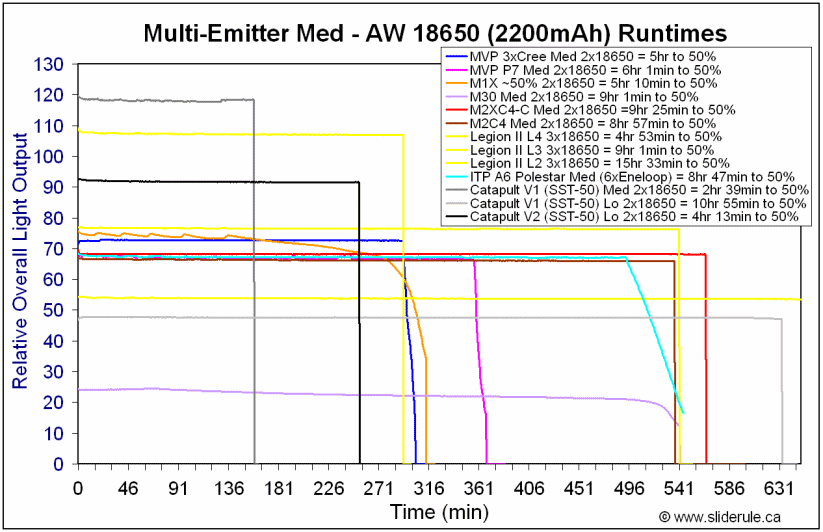



In general terms, the Catapults hold their own well for this class of light. The V2 Lo does seem to be a bit more efficient than the V1 Med/Lo, but that's hard to say for sure given the output differences.
Potential Issues
Although the Catapult now supports a wider voltage range – including 4xCR123A – it is still not recommended to run this light on Hi on 2xCR123A and 2xRCR. The current draw on Hi would greatly exceed what those cells are capable of providing (and risks damaging the cells).
Number of output levels has dropped from three to two, and there is no longer a strobe mode (the latter is no great loss for me, though ).
).
As with many lights of this size and class, no belt holster is provided.
UPDATE June 6, 2010: 1x18650 is officially no longer supported.
Preliminary Observations
ThruNite has provided a few nice upgrades in this V2 Catapult. Is it enough to make you consider upgrading? Read on …
The main functional change is the new head-twist interface. This means you can choose your light mode before turning on, but you are limited to just two output modes (i.e. there is no longer a MCU to provide additional control). Of course, that may not be a bad thing – the new Lo mode is intermediate to the old Med/Lo modes, and is quite useful as a battery saver mode. And at least now you don't have to cycle through a strobe mode on the tailcap clicky like before.
The other key upgrade is support for 4xCR123A configurations. The V1 had a limited voltage input range, so only 2x18650 was support in its extended form.
A nice feature added with this is the new thermal cut-off sensor. Although people may not realize it, 4xCR123A will get a lot hotter than 2x18650, due to the internal resistance of primary CR123A cells. Most makers of high output lights recommend you don't do extended runs on Hi on 4xCR123A, as you risk damaging the circuit/emitter (or worse, the CR123A cells themselves!). But thanks to the 120C temp sensor, the new V2 light should just shut down if excessive heat is detected. Good thinking ThruNite! :twothumbs
Thrunite also claims improved heatsinking, thanks to a larger brass heatsink and improved conductivity to the body. I can tell you in my testing that the new V2 warms up a lot faster on Hi – suggesting heat is indeed being transferred more efficiently to the body. :thumbsup:
The beam profile has not changed in V2. Thrunite claims to be using the highest luminus flux output bin for the SST-50, but I only detected ~5% increase in output and throw on the V2 compared to my original V1. The Catapult remains one of the brightest choices in this high output class.
The rest of the changes are largely cosmetic (i.e. stainless steel bezel) – although it looks like the new o-rings are better quality than before.
Aside from the loss of strobe and the extra output mode, is there anything else you are giving up with this new V2? Well, 1x18650 is no longer supported at all, and 2xRCR/CR123A is only supported on Lo.
So, is the V2 worth upgrading to for existing V1 users? Since the overall form and max throw/output hasn't changed much, I doubt there's a compelling upgrade reason for most people - unless you really want 4xCR123A support or can't stand the tailcap-switch interface (with its ever-present strobe ).
).
But for new purchasers, I would definitely recommend the V2 over the V1 for its wider voltage support, simple and reliable interface, improved heat-sinking, and cut-off thermal protection circuit. :thumbsup: The one caveat is if you plan to use the light predominantly in 1x18650 or 2xRCR-CR123A mode (in Lo/Med levels only!). In that case, you may prefer the wider output/runtime flexibility offered by the V1.
At the end of the day, the Catapult still has one of the nicest beams in this class of light – excellent output, great throw, and remarkably uniform hotspot free of surrounding rings. It is as solid as a tank, with a substantial feel and good grip. And the new interface and circuit help resolve most of the nagging issues I felt the V1 suffered from (from the conclusion of my V1 review: The one area where I think some refinement is needed is in the circuit – both for feature set and battery flexibility). In my books, the V2 is definitely a nice update - well done.
Warning: pic heavy, as usual
Manufacturer Specifications: (taken from the ThruNite CPFMP thread and Battery Junction's website).
Please see my earlier V1 review for comparison specs.
- Super bright Luminus SST-50 emitter —with the highest flux bin produced
- Maximum of 1000 emitter lumens on high (~700 OTF)
- 2 Output Levels: High 1000 Lumens, Low 250 Lumens
- Reverse polarity protection
- Operating voltage between 2.7V to 8.4V
- Drive Current to LED:High 3A, Medium 1.5A, Low 750ma
- Mil-Spec Type III Hard Anodized
- Constructed of 7075AL for superior durability
- Length: 185mm; Head diameter: 58mm; Body diameter: 31mm;
- Weight: 390g. (Extended tube excluded)
- Tactical momentary-on forward click switch
- IPX-68 Water/Dust Resistane
- Tail cap design allows the light to tail stand
- Anti-shatter ultra clear lens with double-sided multilayer AR coating
- 54mm smooth reflector for throw
- Stainless steel bezel
- Battery Options: 2 x 18650, 2 x 17670, 4 x CR123, or 2xCR123/16340 (for low stage only)
- When using the included extender tube for either 2 x 18650 or 2 x 17670 configuration, insert the extender between the head and the battery tube. The extender may not make contact when installed between the tailcap and battery tube.
- Voltage cut-off occurs at 2.7V to protect rechargeable batteries. It will flash at 5.2V to indicate low battery voltage for two Rechargeable batteries.
- MSRP: $160
In addition to the specs above, here are the main changes (according to ThruNite):
- Re-designed driver without a MCU, allowing the light to accept higher input voltage and current, and allow a greater range of operating temperatures (-30C to +130C)
- New IC with higher efficiency and one that produces less heat
- Added automatic overhead shutdown function. When the circuit senses >120C, it automatically shuts down. When it falls to <120C, it can be turned on again
- 2oz brass PCB used to increase heat dissipation
- Eliminated an anodized layer between the LED and the electronics housing, allowing heat to dissipate more effectively.
- Aluminum bezel has been replaced with a stainless steel one for higher impact resistance
- Two output levels, controlled by a loosen-tighten twist of the head
- Support added for primary CR123A batteries, 4x or 2x (the latter only for Lo mode).





The V2 light comes with a simpler carboard case with cut-out foam. Inside, you will find the light, extension body tube, warranty card, wrist lanyard, spare o-rings and extra tailcap clicky switch and GITD boot cover.
Here is how it looks in my hands, and compared to a couple lights of its class:



From left to right: AW 18650 Protected, Catapult V2, Catapult V1, JetBeam M1X, Tiablo ACE-G, EagleTac M2C4 (all with battery extenders)


From left to right: AW 18650 Protected, Catapult V2, Catapult V1, Olight M30, JetBeam M1X, JetBeam Jet-III M (all without battery extenders)
Catapult V2 Weight (no battery): 375.7g (no extender), 446.4g (with extender)
Catapult V2 Dimensions: 187mm (no extender), 254mm (with extender), Width (bezel) 58.0mm, Width (tailcap) 35.0
Catapult V1 Weight (no battery): 339.3g (no extender), 410.5g (with extender)
Catapult V1 Dimensions: Length: 182mm (no extender) 250mm (with extender), Width (bezel) 59.0mm, Width (tailcap) 34.4mm
As you can see, most of the difference has been around the head of the light – with an additional ~36g and ~4.5 mm in length. This is presumably to accommodate the greater heatsink and the new head-twist output control mechanism.
What hasn't changed is the over dimensions, design, screw threads or checked pattern of the handle/battery tube and tailcap. These parts are interchangeable between the versions. Note however that they have switch to slightly thinner (but more durable looking) black o-rings at all junction points.
Grip remains excellent – the Catapult has some of deepest cut checkered patterning that I've ever seen on the surface of a light. Anodizing is comparable between the versions, but lettering is now brighter in appearance than before.

As you can see, the light can tailstand as before (the raised ridges also serve as attachment points for the wrist lanyard). The switch has the same feel as before, and is fairly typical for standard forward clicky switch.

The tailcap is another change – instead of a bare gold-plated spring, there is now a battery contact cap (with a spring underneath). The gold-plated spring mounted on the positive contact board in the head seems comparable (and newer high-capacity flat-top 18650 cells still work fine
Screw threads in the tailcap and on the corresponding battery tube remain anodized, allowing for lock-out. :thumbsup:
FYI, as before, the extender portion battery tube goes between the head and the main body tube, not between the main body tube and switch (as is the case on most other lights). It's important you don't try to install it the wrong way, or it will interfere with battery contact (i.e. the anodized screw threads will be in the wrong place).



Now much has visibly changed here, except for the stainless steel bezel. My sample came with the standard smooth reflector (although I understand OP is available). Of note – while the lens retains some purplish-tinged anti-glare coating, it is much less noticeable than on my earlier V1 sample.
Beamshots
To start, here are some "white-wall" beamshots, comparing the V1 and V2 Catapult. Both lights are on Hi on 2x18650 AW protected cells.
The first set is taken ~0.5m from a while wall, to show you the spillbeams:




The second set is taken ~2.5m, to show you the hotspots:




I think you will agree - not much of a difference. Frankly, you can only tell a difference using testing equipment. You can check out my V1 review for some additional beamshots.
To better compare the throw and spill of the V2 compared to other high output lights, here are some outdoor shots from my High Output Round-up Review, showing a point ~ 10 meters from the lights. These were taken at different times for different reviews, so they may look a little different (e.g. I planted a tree at the end of last summer :laughing








And here are some lower exposures to better show you the hotspots:








As I think you can see, the Catapult has the greatest throw of any of these lights. :thumbsup:
UPDATE: Some additional long-distance beamshots, to show you how the light compares to others in its class.
Please see my recent 100-yard Outdoor Beamshot review for more details (and additional lights).



User Interface
The Catapult V2 uses a very simple interface – twist the head tight for Hi, loosen slightly for Lo. Turn on/off by the forward clicky switch (press-on for momentary, click-on for stay on). :kiss:
There is no longer a strobe mode.
Like before, I am unable to detect any sign of PWM at either level with my home-made sound card-oscilloscope setup. :thumbsup: So either the light is current-controlled, or the frequency is incredibly high and undetectable.
Note the voltage range of the circuit has changed – from 2.7V–8.4V on the V1 to 3.7V-13V on the V2. This means you can now run the light in 4xCR123A or 2xCR123A/RCR configurations. :thumbsup:
The light also has a thermal sensor, and will cut-out if the temperature exceeds 120C. A good safety feature, especially when running 4xCR123A on Hi (the internal resistance of those cells can result in a lot more heat being generated when placed under a high load).
Testing Method: All my output numbers are relative for my home-made light box setup, a la Quickbeam's flashlight reviews method. You can directly compare all my relative output values from different reviews - i.e. an output value of "10" in one graph is the same as "10" in another. All runtimes are done under a cooling fan.
Throw values are the square-root of lux measurements taken at 5 meters from the lens, using a light meter, and then extrapolated back to estimate values for 1 meter. This will be my standard way to present throw on these types of high output lights from now on. The beams don't really have a chance to fully converge until typically several meters out
Throw/Output Summary Chart:

Consistent with ThruNite's claims, max output has increased slightly on my V2 sample (by about ~5% overall). The Lo mode is actually intermediate to the Med/Lo modes of the V1 (scroll down for the runtime comparisons).
Output/Runtime Comparison
Note: Effective January 2010, all CR123A runtimes are now performed solely on Titanium Innovations batteries sponsored by BatteryJunction.com. You can compare the generally excellent performance of these CR123A cells relative to the Duracell/Surefire cells used in all my earlier reviews here. I have marked all the new runtimes of lights with Titanium Innovations CR123As on the graphs with an "*".
All 18650 runtimes are done on older AW protected cells (2200mAh), for comparison purposes.
To start, here are some comparisons between the V1 and V2 Catapults:

Some interesting differences … first off, note that the new V2 Lo mode is intermediate to the previous V1 Lo and Med modes. Efficiency may be slightly improved on the V2 version's Lo mode.
The V2 now supports 4xCR123A, and the Hi level run is unusual – after 27mins, the light drops to a lower regulated level (lower even than the Lo mode). After another 30 mins at this level, output slowly begins to climb back up to the set Lo level – at which point, regulation cuts-off and the light gradually decays in output. The Lo mode on 4xCR123A was perfectly flat in comparison.
I'm not sure why it does this on Hi on 4xCR123A, but it may have something to do with the thermal protection circuit. :thinking: Due to the internal resistance of the primary CR123A cells, lights will get a lot hotter on 4xCR123A than they do on 2x18650 (for the same Hi output). Although the V2 manual says the light with shut-off if 120C is reached, I wouldn't be surprised if this behavior were somehow related to the heat sensor.
Note that all my tests on done under a cooling fan, so I would expect this to occur even earlier under no cooling.
UPDATE June 6, 2010: Catapult does not recommend trying to run the light on Hi in 1x18650/2xRCR123A configuration. In fact, 1x18650 has officially been removed from the specs. Based on the original proposed specs, I did it a test on 1x18650 but have removed the results - it seems 1x18650 does not seem to work for others who have tried it.
Best to stick with ThruNite's recommendation for 2xCR123A/RCR on Lo only, I think.

On 2xRCR/CR123, performance is as I would expect for the Lo output level. Note that once the light drops out of regulation on 2xCR123A, severe flickering occurs. This continues until the cells are exhausted.
Here is how the V1 and V2 lights compare to the other High Output (2x18650) competition:





In general terms, the Catapults hold their own well for this class of light. The V2 Lo does seem to be a bit more efficient than the V1 Med/Lo, but that's hard to say for sure given the output differences.
Potential Issues
Although the Catapult now supports a wider voltage range – including 4xCR123A – it is still not recommended to run this light on Hi on 2xCR123A and 2xRCR. The current draw on Hi would greatly exceed what those cells are capable of providing (and risks damaging the cells).
Number of output levels has dropped from three to two, and there is no longer a strobe mode (the latter is no great loss for me, though
As with many lights of this size and class, no belt holster is provided.
UPDATE June 6, 2010: 1x18650 is officially no longer supported.
Preliminary Observations
ThruNite has provided a few nice upgrades in this V2 Catapult. Is it enough to make you consider upgrading? Read on …
The main functional change is the new head-twist interface. This means you can choose your light mode before turning on, but you are limited to just two output modes (i.e. there is no longer a MCU to provide additional control). Of course, that may not be a bad thing – the new Lo mode is intermediate to the old Med/Lo modes, and is quite useful as a battery saver mode. And at least now you don't have to cycle through a strobe mode on the tailcap clicky like before.
The other key upgrade is support for 4xCR123A configurations. The V1 had a limited voltage input range, so only 2x18650 was support in its extended form.
A nice feature added with this is the new thermal cut-off sensor. Although people may not realize it, 4xCR123A will get a lot hotter than 2x18650, due to the internal resistance of primary CR123A cells. Most makers of high output lights recommend you don't do extended runs on Hi on 4xCR123A, as you risk damaging the circuit/emitter (or worse, the CR123A cells themselves!). But thanks to the 120C temp sensor, the new V2 light should just shut down if excessive heat is detected. Good thinking ThruNite! :twothumbs
Thrunite also claims improved heatsinking, thanks to a larger brass heatsink and improved conductivity to the body. I can tell you in my testing that the new V2 warms up a lot faster on Hi – suggesting heat is indeed being transferred more efficiently to the body. :thumbsup:
The beam profile has not changed in V2. Thrunite claims to be using the highest luminus flux output bin for the SST-50, but I only detected ~5% increase in output and throw on the V2 compared to my original V1. The Catapult remains one of the brightest choices in this high output class.
The rest of the changes are largely cosmetic (i.e. stainless steel bezel) – although it looks like the new o-rings are better quality than before.
Aside from the loss of strobe and the extra output mode, is there anything else you are giving up with this new V2? Well, 1x18650 is no longer supported at all, and 2xRCR/CR123A is only supported on Lo.
So, is the V2 worth upgrading to for existing V1 users? Since the overall form and max throw/output hasn't changed much, I doubt there's a compelling upgrade reason for most people - unless you really want 4xCR123A support or can't stand the tailcap-switch interface (with its ever-present strobe
But for new purchasers, I would definitely recommend the V2 over the V1 for its wider voltage support, simple and reliable interface, improved heat-sinking, and cut-off thermal protection circuit. :thumbsup: The one caveat is if you plan to use the light predominantly in 1x18650 or 2xRCR-CR123A mode (in Lo/Med levels only!). In that case, you may prefer the wider output/runtime flexibility offered by the V1.
At the end of the day, the Catapult still has one of the nicest beams in this class of light – excellent output, great throw, and remarkably uniform hotspot free of surrounding rings. It is as solid as a tank, with a substantial feel and good grip. And the new interface and circuit help resolve most of the nagging issues I felt the V1 suffered from (from the conclusion of my V1 review: The one area where I think some refinement is needed is in the circuit – both for feature set and battery flexibility). In my books, the V2 is definitely a nice update - well done.
Last edited by a moderator:


 by running 2XCR123A/RCR on Hi.
by running 2XCR123A/RCR on Hi.